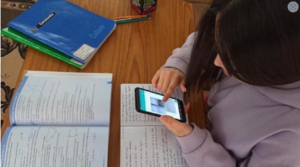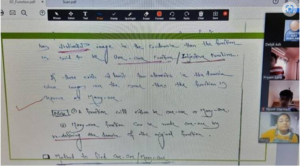Dominic Blanc
Education is praised by most to be the most important asset in the world. But both the world and education is changing through digitalization. Will this change the social inequality that is found in education for the better, or will it widen the rift between those who can afford education versus those who can’t?
Rise of digital education
Especially during the Covid-19 Pandemic digital education has become more relevant than ever. Many teachers were forced to switch to online lessons in early 2020. This speed up a trend that has already been going since 2014 in Switzerland. This was because the “Lehrplan 21” was finished then and was started in the regular curriculum in 2018 (Deutschschweizerische Erziehungs Gesellschaft (D-EDK), 2014). This new curriculum brought with it the subject ICT and for this subject every child in secondary school was required to have a tablet (Regionaljournal Aargau Solothurn, 2020). The general goal was to teach children the handling of digital media and modern technology. Those handling capabilities were put to the test for both teachers and pupils when the Covid-19 pandemic forced schools to switch to online classes. Zoom, One Drive and Microsoft Teams were suddenly programs which were in high demand. Many teachers used these programs for either online video classes or filesharing remote from home or school. The pupils could stay at home and work on their assigned tasks or view lessons (Deutschschweizerische Erziehungs Gesellschaft (D-EDK), 2014).
Now compared to Swiss education before the pandemic this was a major loss in quality. Principals realized that to improve online classes teachers needed further education in ICT themselves (Jaggi, 2021). This of course came with its price. In an SRF article Charlotte Jacquemart talks about the increase in ICT classes for teachers. It is noted that not all municipalities may have enough financial resources to complete these ICT advancement classes and this was in 2017 before the rise during the pandemic (Jaquemart & Kobler, 2017). This may lead to social differences in the quality of education and therefore into more social segregation. Now this might be a minor problem in Switzerland looking at this on a global perspective it becomes highly relevant.

Figure 1:Digital education under Covid-19 pandemic. Homeschooling: Digital Education (Albania & Council of Europe Office in Tirana, 2020)
Digital revolution in Education as part of SDG 4
As a small recap SDG 4 of the United Nations is to ensure inclusive and equitable quality education and promote lifelong learning opportunities for all. To do this the digital revolution has already contributed a great deal and shall continue to do so. But what exactly does this mean? The UN SDGs have a Fund site which states how digital development and with it a brand new era of technology can help advance SDG 4. On their site they write the following: “Digital education technologies improves fundamental skills such as collaboration, problem solving and global awareness. It can easily connect boys and girls from different parts of the world with the possibility of sharing their content with peers living kilometres away. Equally important, learning technology can open future job opportunities.”(United Nations Development Programme (UNDP), 2022)
As can be seen the digital revolution can be especially in online communication can make a major difference in the advancement on SDG 4. It would be desirable as a community to collaborate, to develop global awareness and maybe advance in other SDGs together. Also in a more practical application millions of people in rural areas would gain access to higher education whilst still being available at home. This approach sounds like a good idea but might be worth some more thought. Here’s why.
Social and Digital inequality for the poor
Developing countries are mostly those who still struggle on SDG 4. Often Poor people have no access to education on a financial level. This is often combined with no access to education because of distance because most uneducated people remain in rural areas. This lack of access to education has already opened up big social inequality. Most poor people remain in rural areas because their lack of education denies them better jobs in the city for example. Now of course these are complicated socioeconomic dynamics and not always exactly this simple. However I would argue that a tendency is clearly visible.
Now things get complicated when adding digital education to the equation. On the one hand the poor might not be able to afford digital devices such as phones, tablets and laptops for education online. This has proven to be less of a barrier, however the lack of internet access has proven to be the biggest challenge (Liming & Haiming, 2020). It is well possible that instead of improving an equal access to education through a digital revolution, it might result in more inequality. Only pupils and students with good internet access could participate. Inequality would continue in new forms. This time distance isn’t such an issue but finance and infrastructure is.

Figure 2:Online learning a challenge for teachers, students in India. Online classes conducted by Debjit Ash, Deputy HOD, Maths, FIITJEE Kolkata. Image courtesy: Screengrab/ shared (Ash, 2020)
Digital Revolution as a chance for the poor
The aspects of access to digital education might not be optimal for the poor, however there are arguments to be made that it nonetheless benefits the poor. To demonstrate this I would like to share a story of a friend of mine from Bangladesh. This friend grew up in a very poor family. In fact so poor that they lived on the streets homeless for some years. Now my friend luckily received a primary education in the outskirts of Bangladeshs capital Dhaka. At a very young age this friend had to start working for his family to maintain their existence. He found work at a local café and had regular shifts. Enough money was made to purchase a laptop and from then on my friend participated in online classes during the night. He achieved secondary school and went on to do the International General Certificate of Secondary Education (IGCSE) exams with success. The IGCSE is an international valid certificate for secondary education.
To summarise, a small income paired with digital education for the poor can lead to a major change in social and educational hierarchy. That poor people with small income and stable internet access in the city can be educated very efficiently without big expenses of housing, books or travel. All these factors lead me to believe that even though technology may come with a price it may be a huge chance to revolutionize education and with it achieve SDG 4.
Digital Revolution as the solution to SDG 4
As seen in China and in Switzerland digital education can lead to tensions between the rich and poor both in person and in municipalities. Inequality might be a consequence of a digitalization. Digitalization can also be a cheap solution for education to the poor. This is the case for primary, secondary and higher education. Especially for higher education abroad much money can be saved through a online course. Also digitalization can lead to progress through exchange of solutions and ideas among pupils and students. To give a personal example of this, during the preparation for my Basis Prüfung I regularly consulted videos made by people from India on difficult math questions. This shows well how education can be shared digitally. This of course also applies to sharing data together which also a big part of a digital revolution.
Coming back to education and SDG 4, I truly believe that a digital education is the form of the future. I would certainly encourage offline courses as they are more personal. However I think it to be necessary that online classes are normalized and less frowned upon. The potential in online classes could serve a great purpose in the fulfilling of SDG 4. For this to succeed different steps have to be done. In Switzerland a good integration of digital media and technology has to be applied. Teachers must be educated more on digital courses and money has to be invested in devices, service and networks. In developing countries and countries with big rural areas the first goal should be to provide a stable internet connection. Only when the infrastructure to sustain digital education is given it can be applied. I am aware that this already can be a huge challenge but instead of trying to reach uneducated people by conventional means one could try to skip a step and immediately switch to online education. Much work still has to be done on digital education and SDG 4 lets not sleep on it and miss a chance.
References:
Albania, & Council of Europe Office in Tirana. (2020). Digital education under Covid-19 pandemic – experiences from member states – Newsroom. Retrieved June 1, 2022, from https://www.coe.int/en/web/tirana/-/digital-education-under-covid-19-pandemic-experiences-from-member-states
Ash, D. (2020). Poor connectivity, lack of smartphones: Online learning a challenge for teachers, students | Education News,The Indian Express. Retrieved June 1, 2022, from https://indianexpress.com/article/education/coronavirus-what-kind-of-challenges-teachers-are-facing-in-online-module-nitdgp-ac-in-iitkgp-ac-in-6342278/
Jaquemart, C. & Kobler, E. (2017). Digitalisierung der Schule – Riesiger Bedarf an Weiterbildung der Lehrer – News – SRF. Retrieved June 1, 2022, from https://www.srf.ch/news/schweiz/riesiger-bedarf-an-weiterbildung-der-lehrer
Deutschschweizerische erziehungs Gesellschaft(D-EDK). (2014). Rahmeninformationen Lehrplan 21. Retrieved from www.lehrplan.ch
Jaggi, A. (2021). Unterricht während Pandemie – Wie geht es mit der Digitalisierung an Schulen weiter? – News – SRF. Retrieved June 1, 2022, from https://www.srf.ch/news/schweiz/unterricht-waehrend-pandemie-wie-geht-es-mit-der-digitalisierung-an-schulen-weiter
Liming, L., & Haiming, Z. (2020). Online education is abandoning poor students: an exploration of digital education inequality in China — Digital Culture & Education (ISSN: 1836-8301). Retrieved June 1, 2022, from https://www.digitalcultureandeducation.com/reflections-on-covid19/abandoning-poor-students#
Regionaljournal Aargau Solothurn. (2020). Digitalisierung der Schule – Ein eigenes Notebook pro Schulkind – News – SRF. Retrieved June 1, 2022, from https://www.srf.ch/news/regional/aargau-solothurn/digitalisierung-der-schule-ein-eigenes-notebook-pro-schulkind
United Nations Development Programme (UNDP). (2022). Digital Education | Sustainable Development Goals Fund. Retrieved June 1, 2022, from https://www.sdgfund.org/digital-education